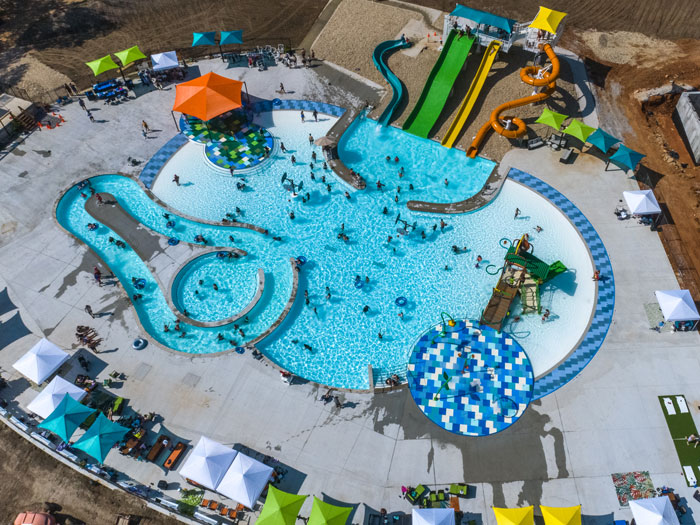In our November 2024 issue, we celebrated our 25th anniversary by taking a look back at some of the biggest trends that have affected the industry since the launch of Recreation Management. Now, with the dawn of the second quarter of the 21st century, we’re turning our lens to some big overarching trends that we—and the 10 industry professionals who contributed their thoughts to this story—expect to have an impact on the way recreation, sports, fitness, and aquatic facilities are planned, designed, and used in the coming years.
These trends fall under three larger umbrellas: financial (and, to a lesser extent, environmental) sustainability, technology, and wellness.
Sustainable in Every Sense
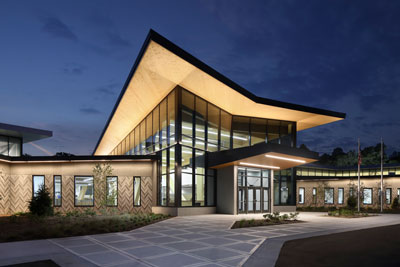
Budgetary pressure is always a challenge, and with facilities becoming more expensive both to build as well as to staff and to maintain, there is a strong need for ensuring facilities are economically sustainable. At the same time, a majority of Americans (61%) say that global climate change is affecting their local community to some degree, according to a 2023 study from the Pew Research Center. Together, these challenges are leading to a greater emphasis on sustainability and resilience in both economic and environmental terms.
“Clearly facilities have become more and more expensive to build,” said Juliene Hefter, executive director and CEO for the Association of Aquatic Professionals. “This is typically the factor that comes into play when communities are deciding whether they should, or, should not, move forward with new recreation, sports, fitness, or aquatic facilities.”
All of these kinds of facilities improve quality of life, she added, but stressed the life-saving relevance of aquatics in particular. “We must continue to stress the importance of requiring swimming lessons at all levels in order to address the epidemic of drowning.”
Steve Langendorfer, Ph.D., vice chair, Aquatics Sub-Council, American Red Cross Scientific Advisory Counsil, professor emeritus at Bowling Green State University, and founding editor of the International Journal of Aquatic Research and Education, said that as the impact of drowning prevention gains a higher profile, he expects the number of school district and public aquatic facilities to grow, but added that “the broader trends associated with climate change and rising costs will have a significant impact.”
He added, “In order to build new and/or renovate existing facilities, improvements in building materials and new designs will need to be implemented,” with materials and technologies featuring a reduced carbon footprint.
“Economic pressures and the need for budget-conscious solutions” will lead to more energy efficiency and cost-effectiveness, agreed Kevin Post, chairman and CEO for Counsilman-Hunsaker. “Facilities will likely look for creative ways to generate additional revenue, such as incorporating rentable spaces for private events or offering year-round programming like indoor aquatic fitness.”
It isn’t just aquatic facilities that will be affected. From parks to fitness clubs, sports centers and beyond, creating sustainable, resilient facilities will drive decisions about design, operations, maintenance, and more.
“This challenge isn’t only about creating recreation facilities but embracing our role as stewards of resources,” said Tom Ohle, AIA, senior partner with RDG Planning & Design. “This means prioritizing carbon-neutral designs, adaptive reuse, and sustainable development whenever possible. With an overabundance of aging facilities, we must reconcile how to meet people’s health and wellness needs without exacerbating resource strain.”
Furthermore, he said that energy efficiency is “no longer optional,” but “essential to staying relevant and responsible. Adopting a holistic approach to design and development will allow us to create facilities that address immediate needs while also supporting long-term sustainability and aligning with broader organizational goals.”
One strategy, he said, takes advantage of available existing spaces and creates a more distributed model. Instead of housing everything—gymnasium, fitness, pool, and more—under a single roof, selective upgrades can be made to address specific programming needs in a cost-effective way. “For example, a gym could be located in one building across town that also houses offices, while group fitness studios might reside in a neighborhood center shared with nonprofits,” Ohle said. “This solution can save costs on construction and promote reuse.”
Aquatic facilities will also be designed for multiple uses, Post said. “For example, a pool might be used for both recreational swimming and lap swimming at different times of day, with movable barriers to change the pool’s layout. Waterparks will also need to offer multifunctional spaces that can be adapted for different seasons and visitor needs, from waterslides to event spaces.”
Bill Ramos, Ph.D., chair, Aquatics Sub-Council, American Red Cross Scientific Advisory Council, and associate professor at the Indiana University School of Public Health in Bloomington, agreed that aquatic facilities will expand in scope, with “… more multigenerational, all-purpose designs … that are more efficient for operations to help address the shortages of qualified aquatic managers.”
Another way to make facilities more sustainable and resilient is through collaboration, which Hefter thinks will increase in the coming decade, “looking at how we can work together with our groups or entities to still provide these amazing facilities, but to do it in a combined way in order to enhance what we are able to offer within communities, but not overlapping in facilities. So many entities within communities are competing for participants. And many just cannot handle the number of individuals that want to be involved.”
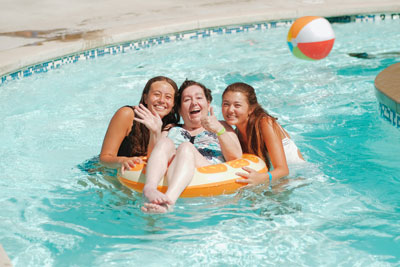
She cited the example of sports, where the emphasis on competition at a young age might have a negative effect on participation. “More facilities need to be planned and designed that address the need to accommodate as many individuals as possible to give them the chance to find out what they might enjoy,” Hefter said. “Too many times we look at things one-dimensionally and need to look at facilities in a broader term of not just having one gym or one type of possible activity.” Instead, she said, multi-use facilities should be built to handle “many different types of activities for community members.”
Already a common focus in facility design, environmental sustainability and responsibility will become a central focus. With regard to aquatic facilities, that means “water conservation, energy use, and eco-friendly materials,” Post said.
And it’s not just aquatics—sustainable practices will continue to grow in facilities of all kinds. “The connection between parks and climate resiliency is becoming increasingly important as parks make efforts to mitigate urban heat island effects, reduce water consumption, and improve community vitality,” said Anne-Marie Spencer, corporate vice president of marketing for Playcore.
Technological Advantages
In conversations at industry events about upcoming trends this past fall, technology was probably the most common topic, including advances on existing technological capabilities as well as speculation about the possible impact of artificial intelligence (AI).
“Even though we joke about AI taking over our jobs, we’ve yet to see it take over our well-being,” Ohle said. “In jest or not, there’s no denying the many positives AI and technology bring to the table. We’re leveraging these tools to enhance safety and security by monitoring facility access and ensuring buildings operate with optimal user comfort. AI-powered workout monitoring is helping us create immersive virtual experiences while tracking equipment usage, and post occupancy surveys that allow us to know whether programming aligns with a space’s intended goals.
“And yet, it’s also clear that technology is a double-edged sword,” he added. “For example, the saturation of image modifications and augmented reality can have both positive and negative effects on user attitudes and mental health. Facilities must anticipate these innovations, adapting thoughtfully to meet evolving expectations while mitigating potential downsides.”
The Health and Fitness Association (HFA) also weighed in on AI’s revolutionary impact on the industry, as the technology offers “… more sophisticated methods to serve members, engage with fitness professionals, and help them meet and track their activity goals. It will also help facility operators refine their marketing strategies and improve member retention by tailoring experiences to individual needs.”
In the realm of aquatics, Hefter said that AI can assist with layers of protection. “These AI developments will never take the place of lifeguards providing constant, direct, uninterrupted supervision at all times, however, they add an extra layer of protection beyond what we have had in the past.”
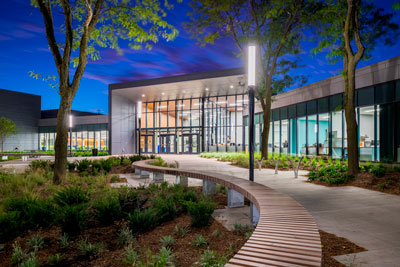
AI can also be a useful tool in the design process, said Stephen Springs, AIR, LEED AP, senior principal with Brinkley Sargent Wiginton Architects, helping with brainstorming and visualizing ideas.
In addition to AI, Springs said virtual reality (VR) technology could have a growing impact, citing a treadmill experience that used VR to provide mountain or jungle scenery, as well as virtual trainers.
Jim Browne, director of recreation business development and planning for Brinkley Sargent Wiginton Architects, said that this experience could be taken further, by considering how to get rid of the goggles and provide an immersive experience, with video projected on “all four walls, ceiling and floor” of a spinning room, for example, “so everyone is cycling through the Swiss Alps together.”
He pointed to the recent NBA All Star Games, which featured a glass floor using fiber optic lighting to create targets or routes. Such technology would allow for a “limitless number of opportunities for games, sports and contests you wouldn’t be able to do with permanent markings and lines,” Browne said. While the cost of such technology might be prohibitive now, if it were to become more available and cost-effective, such technology could expand beyond the floor to walls and ceilings as well, creating “a whole new variety of games and activities we haven’t thought of yet.”
Some waterparks are already seeing one version of this, with waterslides with projection technology creating a different and new experience. Springs said this type of experience could evolve to be used in rec centers too, with the cost of large-scale graphics becoming more affordable.
Erik Kocher, design principal with Hastings & Chivetta Architects, also thinks more simulator-type activities will be developed. “We already have golf, shooting, ice hockey, and even basketball simulators, but these are all static for the player who is essentially just standing in one place,” he said. “I think the next big thing will be simulators you move through and can join your friends in even if they are in another room, state, or country. Think ‘Ready Player One’ joins the recreation universe!”
Springs added that the social aspect of such immersive experiences is important, asking, “How do you get these people who have shifted their fitness to home back out and into a building? It’s the social aspect of it. Post-COVID, I suspect that fitness venues, and to some degree rec centers, might still be struggling with attendance level, and doing something truly immersive might be an experience to get people out.”
Jim Gabel, principal with Hastings & Chivetta Architects, also highlighted the challenge, already a decade old, of “keeping users out of their phones and engaged with one another. Fostering a sense of community in the recreation world has been difficult to achieve, and unfortunately may continue.”
Post cited data-driven personalization as an important trend. When it comes to aquatic facilities, Post said, “… digital platforms may track individual swimming progress, fitness goals, and pool usage patterns, enabling personalized experiences such as custom swim training plans or fitness tracking. Data may also be used to improve facility operations, such as predicting peak usage times and optimizing staffing.”
Browne emphasized the use of such technology for health and wellness, “designing facilities, programs, and equipment that can download data to a person’s phone or device, then collect and use that data with whatever health app they’re using through their doctor’s office and insurance to create a health score or status,” giving end users a “true picture of their wellness.”
Facilities will also increasingly take advantage of existing technologies, especially as they improve over time. “For example, the latest techniques in water disinfection will move from chemicals like chlorine and bromine to ultraviolet radiation and ozone,” said Langendorfer. “In addition, the latest pool alarm programs will help pool staff to be more vigilant and alert to people in drowning situations.”
Technology that improves guest experiences and operational efficiency will only grow more common, Post said. “This includes systems for water quality monitoring, energy management, and automated scheduling for pool access. Additionally, user experience enhancements such as mobile apps for booking, loyalty programs, and virtual waitlists for attractions are expected to grow.”
Whole-Person & Whole-Community Wellness
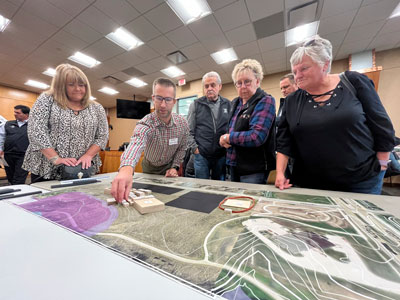
Our conception of “fitness” has been evolving over the past couple of decades, and the coming years are likely to further cement that shift to whole-person—and whole-community—wellness, including mental health. This ties in with multiple trends, including the need for more activities and amenities that can accommodate an aging society, often through an intergenerational, inclusive approach.
Hefter said that health and safety should always be top of mind when considering the activities offered at a facility. “Mental health many times is directly tied to physical health and activity,” she said. “By stressing the importance of participating in any type of physical activity, we put a much higher commitment to individuals’ mental health as well.”
Ohle said such developments will lead to the creation of more holistic wellness programs. “Programming is evolving to encompass not just fitness and recreation, it is expanding to include mental health workshops, nutrition education, and community-building activities,” he said. “Facilities can and should position themselves as hubs for comprehensive wellness, emphasizing inclusivity and accessibility. A truly holistic approach meets people where they are, accommodating their unique abilities and circumstances. To achieve this, we need to shift focus from memberships and locker rentals to participation-driven programs designed for all ages and abilities. This includes offering adaptive sports and intergenerational activities that occur flexibly across multiple locations rather than being confined under one roof.”
Fitness facilities will reflect this shift toward a wellness-oriented mindset, which is already reshaping the landscape, according to the Health and Fitness Association. “We’re seeing a notable increase in the incorporation of recovery services alongside a sustained interest in mind-body offerings and functional fitness. We expect the integration of nutrition and sleep management into the wellness programming in the next 10 years, further enhancing the holistic approach to health and fitness.”
Post also emphasized holistic health and wellness in aquatic facilities, as well as accessibility and inclusivity. “As public awareness of health and wellness grows, aquatic facilities will increasingly cater to holistic wellness,” he said. “In addition to fitness programs like water aerobics or lap swimming, facilities may incorporate spaces dedicated to mental well-being, such as relaxation areas with natural elements or quiet zones. Water-based wellness therapies, including hydrotherapy, will also likely expand.”
The aging population will only further fuel this growth in holistic wellness, and will also drive more intergenerational places and programs, as facilities seek to address not only physical health, but the mental health issues associated with isolation and loneliness, which have been on the rise for more than a decade, and were further exacerbated by the COVID-19 pandemic.
“The global population aged 60 years or over numbered 962 million in 2017, more than twice as large as in 1980 when there were 382 million older persons worldwide,” Spencer said. “The number of older persons is expected to double again by 2050, when it is projected to reach nearly 2.1 billion. Accordingly, interest in using intergenerational strategies to create relevant community programs and social policy is growing. Most relative to this growth is the understanding that our civil society is based on the giving and receiving of resources across the lifespan, and understanding that intergenerational relationships promote the greater good of society.”
Gabel agreed that the aging U.S. population is influencing recreation. “As the population in general gets older, their recreation needs will shift toward more low-impact activities,” he said. “Always providing a wide range of activities will still be necessary to ensure high participation rates.”
“Intergenerational recreation opportunities continue to grow, facility usage changed during the COVID period when families stuck together during outdoor recreation rather than splitting into age groups,” Spencer added. “This trend has continued and we are seeing more intergenerational play areas, like obstacle courses designed for all-age success (as opposed to athletic prowess), and spaces like dog parks and multipurpose fields continuing to grow. Intergenerational activities bring many age groups to one platform, which can increase learning opportunities and build a sense of mutual understanding between generations.
“Intergenerational relationships can also help combat loneliness by opening a wider circle of potential acquaintances, the opportunity to learn new skills, and other life lessons not as familiar to certain age groups, and in creating a sense of purpose,” she concluded.
“Community pools and waterparks will likely emphasize family-friendly programming, including swim classes, family swim sessions, and water play zones for younger children,” Post said. “There will also be increased programming for multigenerational groups, such as ‘grandparent and me’ swim lessons or senior water fitness programs.”
This also will contribute to further growth in adaptive and inclusive programs. “As inclusivity becomes a priority,” Post said, “aquatic centers will offer specialized programs for people with disabilities, including adaptive swim lessons, sensory-friendly swim times, and therapeutic water activities for those with mobility or developmental challenges. Waterparks may create quieter, less stimulating experiences for guests with autism or sensory sensitivities.”
“We need to see facilities that are open to anyone and everyone,” Hefter said. “Too many times the cost to attend or participate is too great for some. These facilities are a great place for those that find themselves alone to be able to meet other individuals and find some common grounds on things that they might enjoy participating in. Those who participate in activities tend to feel better about themselves both physically and mentally.”
Community engagement should be the cornerstone for all facilities, Ohle said. “At their core, facilities rely on people, making it essential to actively engage with communities to understand their needs,” he said. “This connection is vital not only for fostering a sense of identity within the community, but also for ensuring the facility’s long-term success. Planners and designers must prioritize creating spaces that originate from and actively promote gathering and connection. By embedding community engagement into the design process, we can craft environments that reflect the values and aspirations of the people they serve, encouraging meaningful interactions and a sense of belonging.” RM



